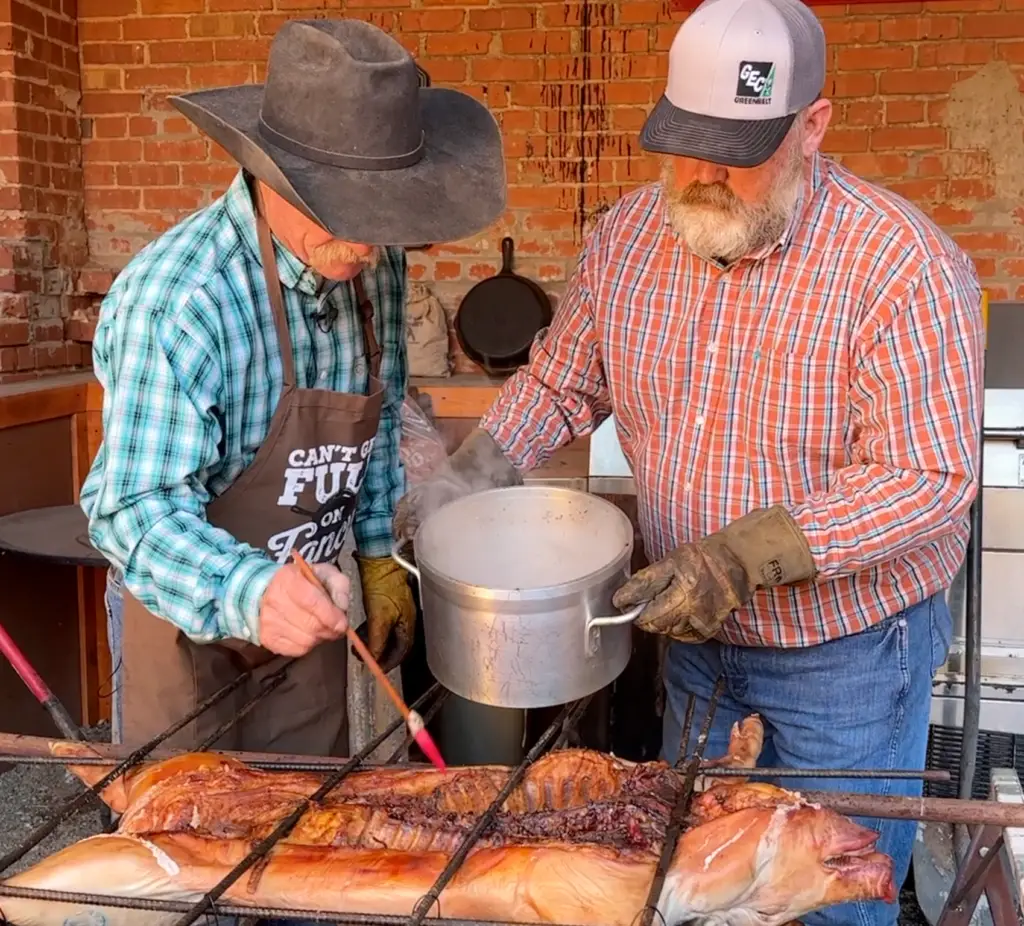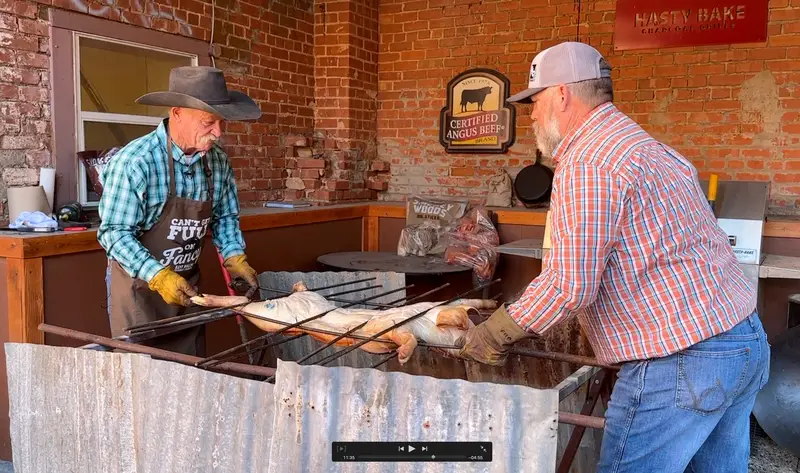Whole Hog Cooking!

Large family gatherings, reunions, and celebrations are often centered around food. On farms and ranches, it is a common practice to roast a whole hog on a spit throughout the day while the kids play and the adults make up for lost time by playing corn hole, horse shoes, or just sitting around with a cold drink enjoying each other’s company.
We appreciate you sharing our recipes with your friends and family!
Roasting a hog on a spit is a pretty simple concept. I set up a couple of saw horses and used some rebar and tin to help harness the heat to roast the hog evenly. I’ll share the tips and tricks I used here, and you can find the recipe below for the details.
If you don’t have the same tools lying around, improvise – once you see how it’s done, there are different ways to engineer the same result. I’d love to hear your feedback if you’ve roasted a whole animal before – please comment below the YouTube video.
How to Prep the Hog
This depends on how you acquired your hog, of course. A butcher will likely do the cleanup for you.
Tip: If you’re wanting to roast your own hog, ask the local butcher! If they can’t get you one, they will certainly know someone who can.
- Start by trimming off any silver skin or membrane from around the inside rib cage. This turns to gristle when cooked and it doesn’t taste good.
- Leave the skin on the hog.
- With the hog laying on its back with the rib cage exposed, push down on both sides of the rib cage at once to flatten the hog. Essentially, you’re trying to get that rib cage and backbone to open up like butterfly wings.
- Dry any moisture inside the hog with paper towels. You want to remove as much moisture as possible and replace that moisture with marinade before and during the cooking process.
- Using half of the marinade, inject generously into the meatiest parts of the hog.
- Generously season the underside of the hog with Rib Rub (you can order mine or use your favorite).
- After you’ve done all of the above, flip the hog over and rub salt generously into the pig skin. This is going to draw out a lot of that moisture we want to replace with marinade.
- Marinade the underside of the hog often throughout cooking.
Roasting the Hog
The most common method of spit roasting a hog is to build a fire, put some saw horses on either side of it, and rotate the spit occasionally while the fire cooks the hog. This method works, but the meat is usually overcooked and burnt by the time the hog is cooked all the way through.
We used saw horses and rebar to create a “flat cage” that exposes the entire hog to the heat while holding the meat still. Start by cooking the hog upside down. If the skin turns brown and crispy before the temperature gets to about 130, go ahead and put some foil on the darkest parts.

We built a “tin house” around the hot coals to help target the heat to the hog. Two tented pieces of tin go over the top while the hog roasts.
What Type of Wood Should I use to Roast a Whole Hog?
Instead of using an open fire, I’m going to use hot coals from the wood stove. Please do not use charcoal briquets. I use a good hardwood lump coal – my preferred brand is FOGO. I find that it burns longer and it makes food taste better.
Tip: Start out with 10 times the cooking wood you think you’ll need – keeping hot coals going for hours will use a lot of wood.

For flavor, add Cherry and Oak wood to the coals throughout the day. Just a few chunks of each is all it takes. When the thickest parts of the hog are between 130 and 140 degrees, flip the hog over and cook the underside.
The hog is ready to serve when fully cooked to an internal temperature of 180 in the hams and shoulders.
Before you go out and get your hog, make sure you watch the video that accompanies this recipe page. There are a lot of great visuals and I’ll show you exactly how to target the heat throughout the process.
When the entire hog is cooked, carve & serve. If you have folks coming over, have them bring their favorite potluck dish!
Delicious Recipes to Serve with Roast Pork
- Smoked Mac and Cheese
- Easiest 1 Hour Yeast Rolls
- Cast Iron Cornbread
- Cowboy Baked Beans
- Loaded Potato Salad
- Tater Tot Casserole
- 7 Layer Bean Dip
As always, Shannon and I thank you for sharing our food! Please follow us on Facebook, subscribe to our e-mail newsletter, and subscribe to our YouTube Channel. We’ll see you at the next hog roast!

Whole Hog Cooking – Cowboy Kent Rollins
Ingredients
- 1 35 to 40 lb. hog
- 6 to 8 tablespoons Kent’s Rib Rub or your favorite pork rub
Hog Injection
- 16 ounces apple juice
- 16 ounces water
- ¼ cup kosher salt
- ¼ cup light brown sugar
- ¼ cup corn syrup
- ¼ cup apple cider vinegar
- ½ cup rib rub
- 2 tablespoons Worcestershire sauce
- 1 stick butter melted
Mexican Mop Sauce
- 2 cups apple cider vinegar
- 4 cups apple juice
- ¾ cup light brown sugar
- 2 tablespoons coarse ground black pepper
- ¼ cup kosher salt
- 1 tablespoon red pepper flakes
- 1 large white onion rough chopped
- 4 Hatch chiles or guajillo peppers or guajillo peppers
Instructions
- To properly prep the pig, please reference our video. Link listed below.
- For the injection: In a medium saucepan, combine all the ingredients and bring to a simmer for about 3 minutes, stirring occasionally.
- Dry the inside and outside of the hog well with paper towels.
- With a syringe, inject the hog in the hams, loins and shoulders, making sure to inject about every 3 to 4 inches apart. Use half of the injection sauce and reserve the remaining sauce.
- Generously season the inside of the hog with Kent’s Rib Rub, or substitute. Rub in the seasoning. Be careful not to get any seasoning on the outside skin of the hog.
- For the Mexican Mop Sauce: combine all the ingredients in a medium saucepan and bring to a boil. Cook for about 15 minutes, or until the onions and pepper are tender, stirring occasionally.
- If cooking the hog running-style, place on a 225 degree F. smoker and cook 5 to 6 hours, or until the internal temps are 165 to 175 degrees F. in the hams, 165 to 170 degrees F. in the loins and 200 degrees F. in the shoulders. Generously baste the hog with the mop sauce at least three times while smoking.
- If cooking the hog splayed out over a pit (as shown in video), lay the hog over the fire meat side down and then sprinkle heavily with salt all over the outer skin. Place coals around the outside edge of the pit, with coals heavily placed directly under the hams and shoulders.
- After 45 minutes, turn the hog over and baste with the mop sauce. Let is set for about 5 minutes then flip the hog back over meat side down, and continue to cook for about 2 ½ to 3 hours.
- When the internal temp of the hams have reached 150 degrees F., flip the hog over, with skin-side down, and continue to cook for another 2 hours, or until the internal temperatures are 165 to 175 degrees F. in the hams, 165 to 170 degrees F. in the loins and 200 degrees F. in the shoulders.
- Remove the hog from the rack and let it rest for about 30 to or until cool enough to handle. Peel back the skin and begin to shred the meat. Serve with additional mop sauce, if desired.
